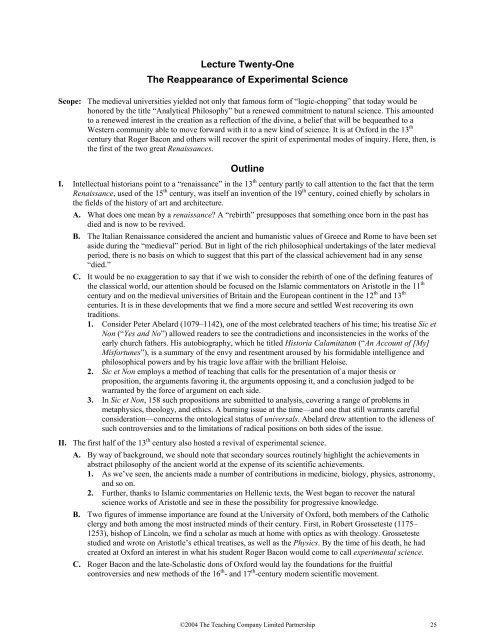Great Ideas of Philosophy
Great Ideas of Philosophy
Great Ideas of Philosophy
- No tags were found...
You also want an ePaper? Increase the reach of your titles
YUMPU automatically turns print PDFs into web optimized ePapers that Google loves.
Lecture Twenty-OneThe Reappearance <strong>of</strong> Experimental ScienceScope: The medieval universities yielded not only that famous form <strong>of</strong> “logic-chopping” that today would behonored by the title “Analytical <strong>Philosophy</strong>” but a renewed commitment to natural science. This amountedto a renewed interest in the creation as a reflection <strong>of</strong> the divine, a belief that will be bequeathed to aWestern community able to move forward with it to a new kind <strong>of</strong> science. It is at Oxford in the 13 thcentury that Roger Bacon and others will recover the spirit <strong>of</strong> experimental modes <strong>of</strong> inquiry. Here, then, isthe first <strong>of</strong> the two great Renaissances.OutlineI. Intellectual historians point to a “renaissance” in the 13 th century partly to call attention to the fact that the termRenaissance, used <strong>of</strong> the 15 th century, was itself an invention <strong>of</strong> the 19 th century, coined chiefly by scholars inthe fields <strong>of</strong> the history <strong>of</strong> art and architecture.A. What does one mean by a renaissance? A “rebirth” presupposes that something once born in the past hasdied and is now to be revived.B. The Italian Renaissance considered the ancient and humanistic values <strong>of</strong> Greece and Rome to have been setaside during the “medieval” period. But in light <strong>of</strong> the rich philosophical undertakings <strong>of</strong> the later medievalperiod, there is no basis on which to suggest that this part <strong>of</strong> the classical achievement had in any sense“died.”C. It would be no exaggeration to say that if we wish to consider the rebirth <strong>of</strong> one <strong>of</strong> the defining features <strong>of</strong>the classical world, our attention should be focused on the Islamic commentators on Aristotle in the 11 thcentury and on the medieval universities <strong>of</strong> Britain and the European continent in the 12 th and 13 thcenturies. It is in these developments that we find a more secure and settled West recovering its owntraditions.1. Consider Peter Abelard (1079–1142), one <strong>of</strong> the most celebrated teachers <strong>of</strong> his time; his treatise Sic etNon (“Yes and No”) allowed readers to see the contradictions and inconsistencies in the works <strong>of</strong> theearly church fathers. His autobiography, which he titled Historia Calamitatum (“An Account <strong>of</strong> [My]Misfortunes”), is a summary <strong>of</strong> the envy and resentment aroused by his formidable intelligence andphilosophical powers and by his tragic love affair with the brilliant Heloise.2. Sic et Non employs a method <strong>of</strong> teaching that calls for the presentation <strong>of</strong> a major thesis orproposition, the arguments favoring it, the arguments opposing it, and a conclusion judged to bewarranted by the force <strong>of</strong> argument on each side.3. In Sic et Non, 158 such propositions are submitted to analysis, covering a range <strong>of</strong> problems inmetaphysics, theology, and ethics. A burning issue at the time—and one that still warrants carefulconsideration—concerns the ontological status <strong>of</strong> universals. Abelard drew attention to the idleness <strong>of</strong>such controversies and to the limitations <strong>of</strong> radical positions on both sides <strong>of</strong> the issue.II. The first half <strong>of</strong> the 13 th century also hosted a revival <strong>of</strong> experimental science.A. By way <strong>of</strong> background, we should note that secondary sources routinely highlight the achievements inabstract philosophy <strong>of</strong> the ancient world at the expense <strong>of</strong> its scientific achievements.1. As we’ve seen, the ancients made a number <strong>of</strong> contributions in medicine, biology, physics, astronomy,and so on.2. Further, thanks to Islamic commentaries on Hellenic texts, the West began to recover the naturalscience works <strong>of</strong> Aristotle and see in these the possibility for progressive knowledge.B. Two figures <strong>of</strong> immense importance are found at the University <strong>of</strong> Oxford, both members <strong>of</strong> the Catholicclergy and both among the most instructed minds <strong>of</strong> their century. First, in Robert Grosseteste (1175–1253), bishop <strong>of</strong> Lincoln, we find a scholar as much at home with optics as with theology. Grossetestestudied and wrote on Aristotle’s ethical treatises, as well as the Physics. By the time <strong>of</strong> his death, he hadcreated at Oxford an interest in what his student Roger Bacon would come to call experimental science.C. Roger Bacon and the late-Scholastic dons <strong>of</strong> Oxford would lay the foundations for the fruitfulcontroversies and new methods <strong>of</strong> the 16 th - and 17 th -century modern scientific movement.©2004 The Teaching Company Limited Partnership 25














